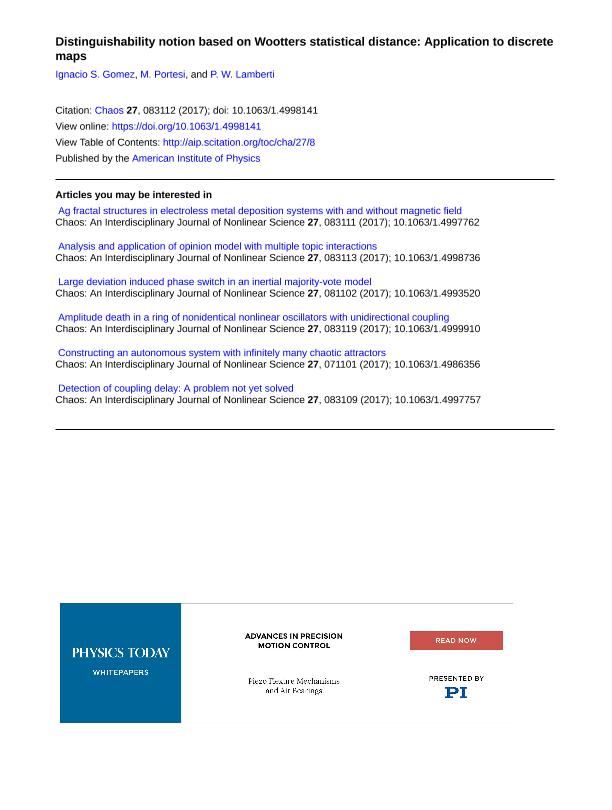Mostrar el registro sencillo del ítem
dc.contributor.author
Gomez, Ignacio Sebastián

dc.contributor.author
Portesi, Mariela Adelina

dc.contributor.author
Lamberti, Pedro Walter

dc.date.available
2018-12-05T14:29:36Z
dc.date.issued
2017-08
dc.identifier.citation
Gomez, Ignacio Sebastián; Portesi, Mariela Adelina; Lamberti, Pedro Walter; Distinguishability notion based on Wootters statistical distance: Application to discrete maps; American Institute of Physics; Chaos; 27; 8; 8-2017
dc.identifier.issn
1054-1500
dc.identifier.uri
http://hdl.handle.net/11336/65842
dc.description.abstract
We study the distinguishability notion given by Wootters for states represented by probability density functions. This presents the particularity that it can also be used for defining a statistical distance in chaotic unidimensional maps. Based on that definition, we provide a metric d for an arbitrary discrete map. Moreover, from d, we associate a metric space with each invariant density of a given map, which results to be the set of all distinguished points when the number of iterations of the map tends to infinity. Also, we give a characterization of the wandering set of a map in terms of the metric d, which allows us to identify the dissipative regions in the phase space. We illustrate the results in the case of the logistic and the circle maps numerically and analytically, and we obtain d and the wandering set for some characteristic values of their parameters. Finally, an extension of the metric space associated for arbitrary probability distributions (not necessarily invariant densities) is given along with some consequences. The statistical properties of distributions given by histograms are characterized in terms of the cardinal of the associated metric space. For two conjugate variables, the uncertainty principle is expressed in terms of the diameters of the associated metric space with those variables.
dc.format
application/pdf
dc.language.iso
eng
dc.publisher
American Institute of Physics

dc.rights
info:eu-repo/semantics/openAccess
dc.rights.uri
https://creativecommons.org/licenses/by-nc-sa/2.5/ar/
dc.subject
Distinguishability
dc.subject
Statistical Distance
dc.subject
Discrete Maps
dc.subject.classification
Astronomía

dc.subject.classification
Ciencias Físicas

dc.subject.classification
CIENCIAS NATURALES Y EXACTAS

dc.title
Distinguishability notion based on Wootters statistical distance: Application to discrete maps
dc.type
info:eu-repo/semantics/article
dc.type
info:ar-repo/semantics/artículo
dc.type
info:eu-repo/semantics/publishedVersion
dc.date.updated
2018-10-22T21:54:35Z
dc.identifier.eissn
1089-7682
dc.journal.volume
27
dc.journal.number
8
dc.journal.pais
Estados Unidos

dc.journal.ciudad
New York
dc.description.fil
Fil: Gomez, Ignacio Sebastián. Consejo Nacional de Investigaciones Científicas y Técnicas. Centro Científico Tecnológico Conicet - La Plata. Instituto de Física La Plata. Universidad Nacional de La Plata. Facultad de Ciencias Exactas. Instituto de Física La Plata; Argentina
dc.description.fil
Fil: Portesi, Mariela Adelina. Consejo Nacional de Investigaciones Científicas y Técnicas. Centro Científico Tecnológico Conicet - La Plata. Instituto de Física La Plata. Universidad Nacional de La Plata. Facultad de Ciencias Exactas. Instituto de Física La Plata; Argentina
dc.description.fil
Fil: Lamberti, Pedro Walter. Universidad Nacional de Córdoba. Facultad de Matemática, Astronomía y Física; Argentina
dc.journal.title
Chaos

dc.relation.alternativeid
info:eu-repo/semantics/altIdentifier/url/aip.scitation.org/doi/full/10.1063/1.4998141
dc.relation.alternativeid
info:eu-repo/semantics/altIdentifier/doi/http://dx.doi.org/10.1063/1.4998141
Archivos asociados
